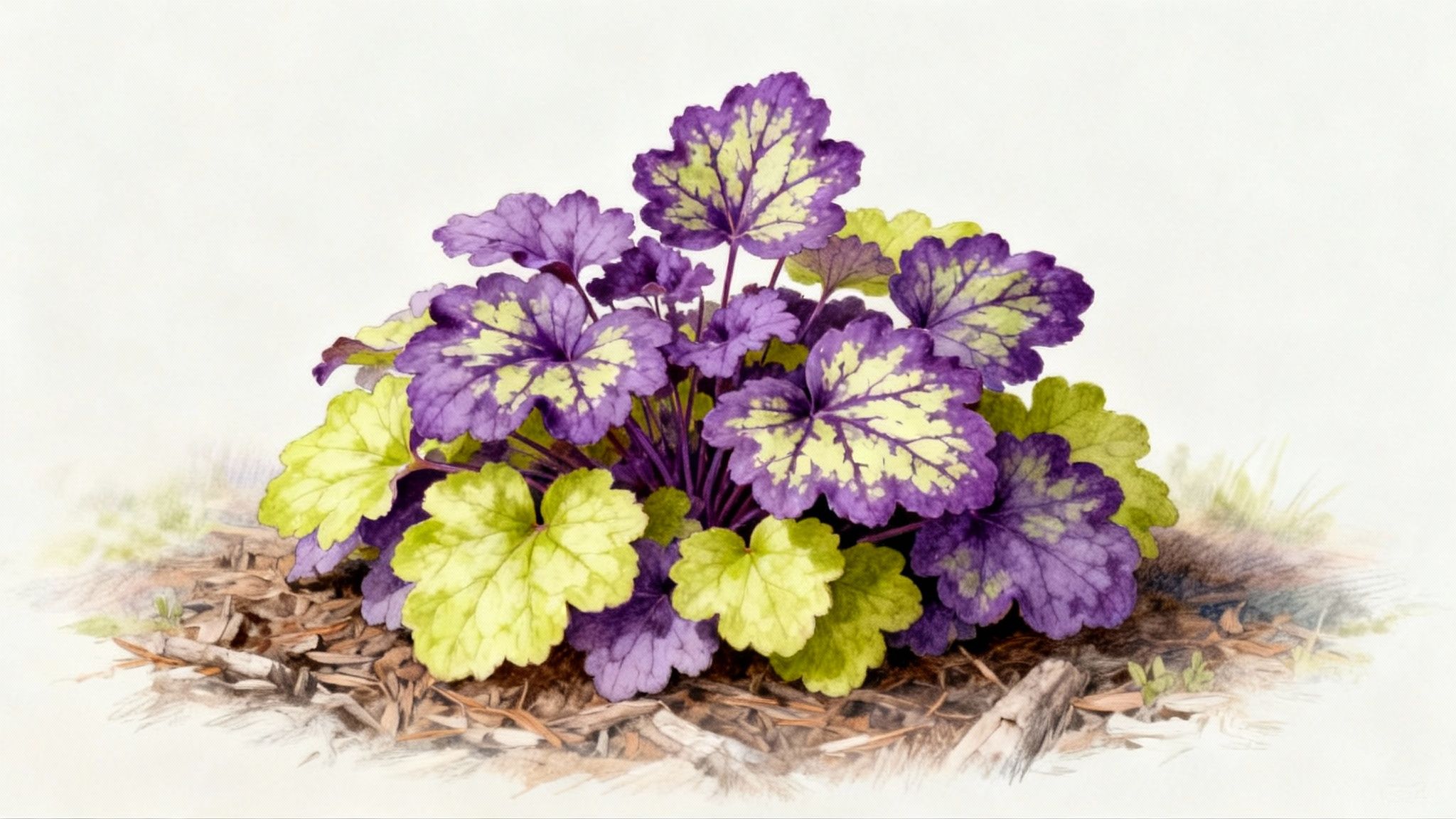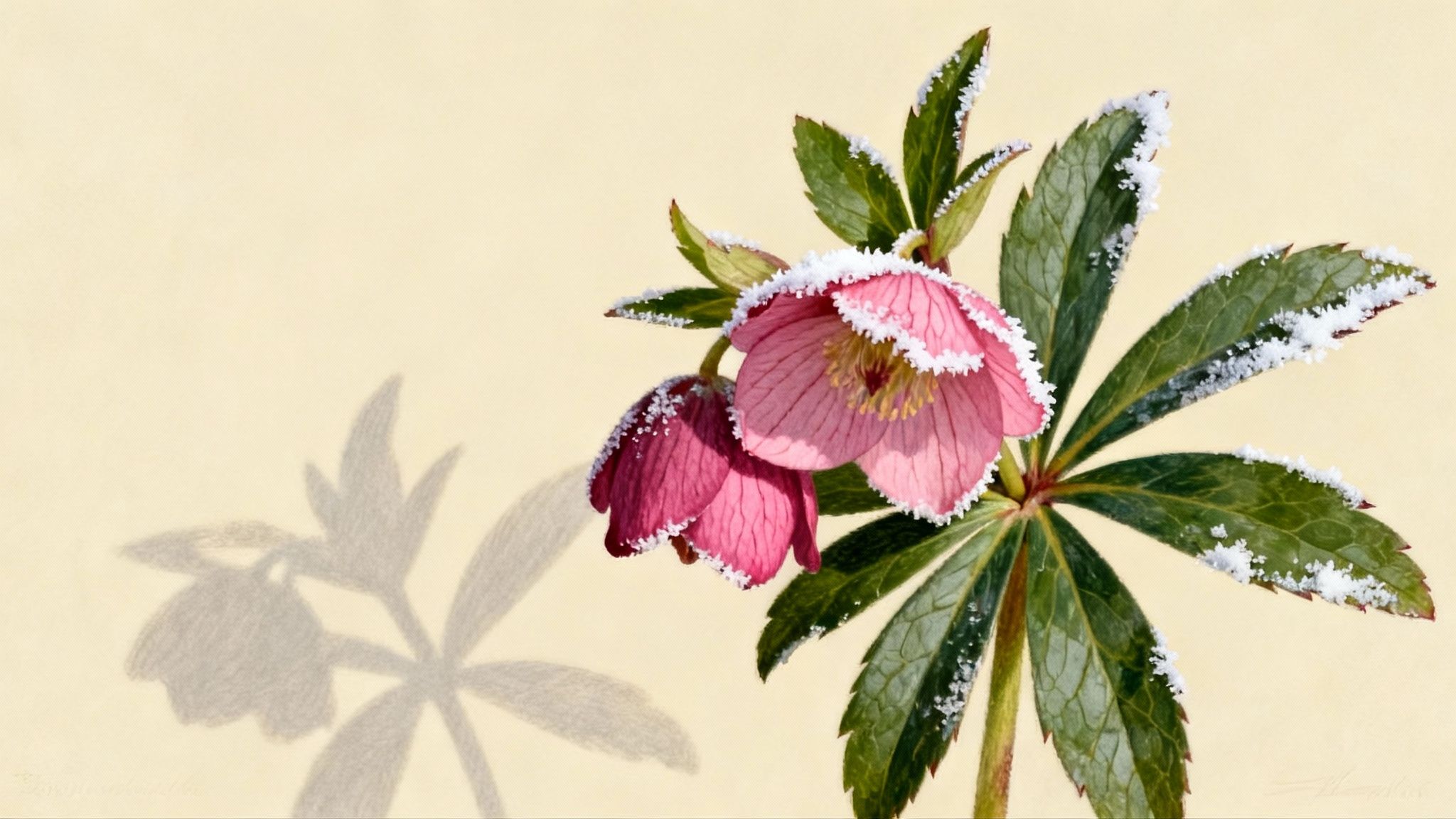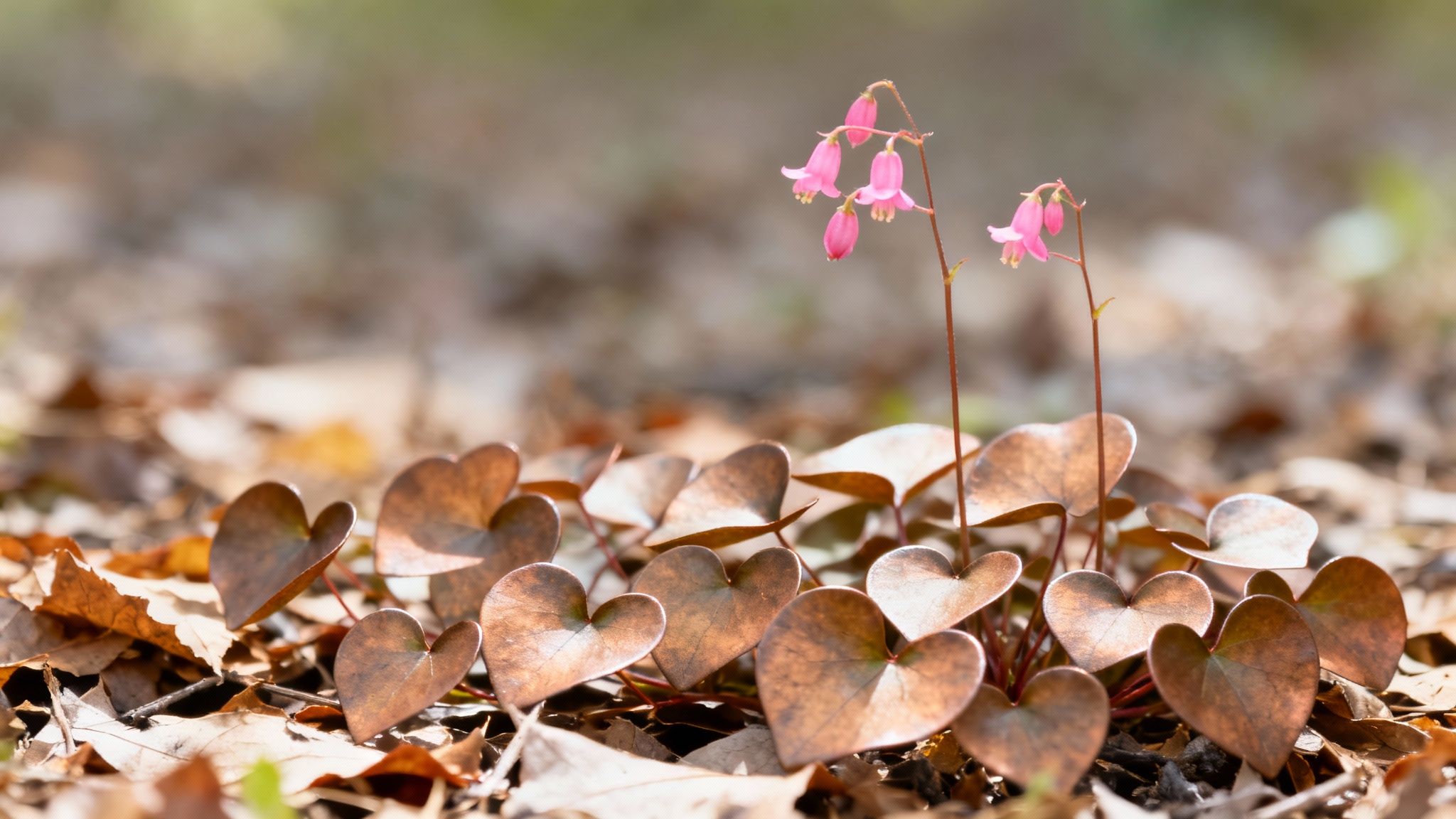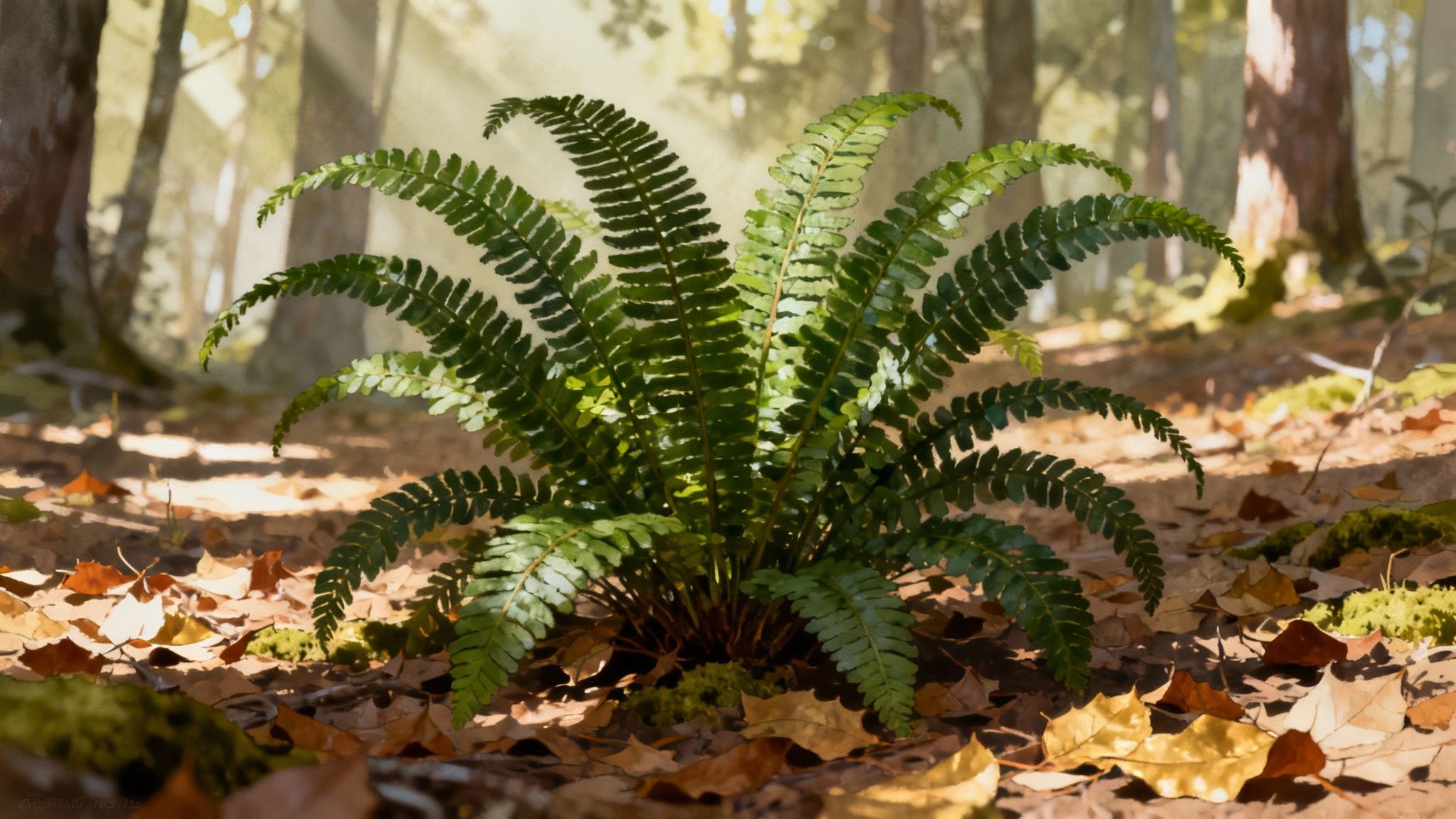Every garden has one: that tricky, dry, shaded spot under a mature tree canopy or along a north-facing wall where nothing seems to thrive. It’s a common frustration for UK gardeners, often leading to resignation and a patch of gravel or neglected soil. But what if that challenging space could become one of the most beautiful, textured, and low-maintenance parts of your garden? Dry shade doesn't have to mean a barren patch of ground.
With the right selection of resilient and beautiful plants for dry shade, you can cultivate a lush, vibrant oasis that flourishes with minimal intervention. These specialised plants have adapted to compete with tree roots for moisture and thrive without direct sunlight, turning a horticultural problem into an opportunity for creativity.
This guide is dedicated to a curated list of exceptional performers that not only survive but truly shine in these demanding conditions. From the architectural foliage of Bear's Breeches to the delicate winter blooms of Hellebores, these plants offer year-round interest and prove that the most difficult spots can yield the most rewarding results. Let's transform that problem area into a showcase of horticultural ingenuity.
1. Heuchera (Coral Bells)
Heuchera, commonly known as Coral Bells, is a powerhouse perennial for challenging garden spots. Its main draw is the spectacular foliage, which forms neat mounds of lobed leaves in an astonishing array of colours, from deep burgundy and rich plum to vibrant chartreuse and warm bronze. While they produce delicate, airy flower spikes in late spring or summer, the leaves provide year-round structure and colour, making them one of the best plants for dry shade.

Native to North American woodlands, Heuchera has been extensively hybridised, resulting in cultivars that are exceptionally tolerant of dry conditions once established. They thrive in the dappled light beneath trees or along the north side of a house, areas where many other plants fail to flourish. Their compact, mounding habit makes them a perfect choice for edging pathways, filling gaps in borders, or creating a tapestry of contrasting hues in a container.
Growing and Care Tips
To ensure your Heuchera thrives in dry shade, follow these specific guidelines for planting and maintenance.
- Planting Time: Settle them into the ground in autumn or early spring. This gives the roots time to establish before the stresses of summer heat or winter cold.
- Soil Preparation: While drought-tolerant, they appreciate well-drained soil. Amend heavy clay or poor soil with a generous amount of compost or leaf mould to improve drainage and provide initial nutrients.
- Mulching: Apply a light layer of bark chips or leaf mould around the base. This helps retain soil moisture but be careful to keep the mulch away from the plant’s crown to prevent rot.
- Maintenance: Every three to four years, lift and divide the clumps to reinvigorate them and maintain their tidy shape. This is best done in early spring.
Heucheras are wonderfully versatile and can be used to create stunning combinations in garden borders. For more inspiration on pairing them with other plants, you can explore some brilliant garden border plant ideas to elevate your design.
2. Helleborus (Lenten Rose / Christmas Rose)
Helleborus, known as the Lenten Rose or Christmas Rose, is an exceptional evergreen perennial, treasured for its ability to bloom during the coldest months when little else is in flower. Its main appeal lies in the stunning winter colour from its nodding, cup-shaped flowers, which appear in shades of cream, white, pink, deep burgundy, and even speckled bi-colours. The leathery, deeply lobed foliage remains an attractive feature all year, making Helleborus a cornerstone for any garden needing winter interest.

This plant is one of the best choices for dry shade, thriving beneath deciduous trees where it is sheltered from harsh summer sun but receives winter light. Once established, its deep root system makes it surprisingly drought-tolerant. The robust, architectural foliage provides excellent ground cover, suppressing weeds and adding texture to woodland-style plantings or shaded borders. Its resilience and striking appearance make it a true garden hero.
Growing and Care Tips
To get the most from your Helleborus in a dry, shaded spot, follow these specific guidelines for planting and ongoing care.
- Planting Time: Settle plants into the ground in autumn. This allows their root systems to establish over the winter, preparing them for the following summer's dry spells.
- Soil Preparation: Although tolerant, they perform best in rich, well-drained soil. Amend the planting area with leaf mould or well-rotted compost to mimic their native woodland habitat.
- Maintenance: In late winter or very early spring, just before new flower stems emerge, cut back the old, tattered leaves to the ground. This tidies the plant and showcases the new blooms.
- Watering: Provide consistent moisture during their first growing season to help them establish. Afterwards, they will require very little supplemental watering.
- Safety Note: Always wear gloves when handling Helleborus, as its sap can be a skin irritant.
Hellebores are a fantastic choice for a low-effort garden, requiring minimal fuss once they are settled in. For more inspiration on creating a beautiful yet manageable outdoor space, discover these brilliant low-maintenance garden ideas to simplify your routine.
3. Epimedium (Bishop's Hat / Fairy Wings)
Epimedium, charmingly known as Bishop's Hat or Fairy Wings, is a superb ground-cover perennial that excels in difficult dry shade conditions. Its primary appeal lies in its delicate, heart-shaped leaflets and unique spurred flowers that float above the foliage in spring. Spreading slowly via rhizomes, it forms dense, weed-suppressing mats, making it one of the most reliable and graceful plants for dry shade.

This underutilised gem provides multi-season interest, with many varieties displaying beautiful bronze or reddish tints on new spring foliage and again in autumn. Native to woodland settings, Epimedium is exceptionally tough and well-suited for planting beneath trees with competitive surface roots, a challenge for many other plants. Its refined texture and quiet beauty bring a touch of woodland elegance to forgotten corners of the garden.
Growing and Care Tips
To get the best performance from your Epimedium in a dry, shady spot, follow these specific care instructions.
- Planting Time: Establish plants in autumn or early spring to allow their root systems to develop before the summer dry spells. Space them 12 to 18 inches apart to encourage quicker coverage.
- Soil Preparation: Although tolerant of poor soil, Epimedium will establish faster in soil amended with leaf mould or well-rotted compost. This improves structure and moisture retention.
- Mulching: Apply a light layer of leaf mould or shredded bark annually in autumn. This mimics their natural woodland floor environment and helps conserve moisture.
- Maintenance: In late winter or very early spring, before new growth appears, shear back the old, semi-evergreen foliage. This simple task reveals the delicate flowers and allows the fresh, colourful new leaves to shine. Established clumps can be divided in autumn if you wish to propagate them.
4. Polystichum acrostichoides (Christmas Fern)
For gardeners seeking year-round structure and lush greenery in challenging spots, Polystichum acrostichoides, or Christmas Fern, is an exceptional choice. This native evergreen fern forms elegant, arching fronds that maintain their rich green colour throughout the seasons, providing consistent texture and form. Its ability to thrive in dry woodland conditions once established makes it one of the most reliable and beautiful plants for dry shade.

Named for the historical practice of using its tough fronds in holiday decorations, Christmas Fern is a true workhorse. It naturally inhabits the forest floor, making it perfectly adapted to the dappled light and drier soils found beneath mature trees or on north-facing slopes. Its non-spreading, clumping habit allows it to blend seamlessly into native plantings or act as a sophisticated ground cover without becoming invasive, offering a dependable splash of green where little else will grow.
Growing and Care Tips
To get the best from your Christmas Fern and ensure it thrives in a dry, shaded location, follow these specific guidelines.
- Planting Time: Plant in the autumn to allow the root system to establish over the cooler, wetter months before the stress of summer.
- Soil and Location: This fern is adaptable but performs best in well-drained, humus-rich soil. It is an excellent choice for stabilising soil on shady slopes. Avoid areas where road salt may accumulate in winter.
- Mulching: Apply an annual top dressing of 2-3 inches of leaf mould or compost in the autumn. This mimics its natural woodland environment, retaining moisture and enriching the soil.
- Spacing: When planting in groups, space the ferns 12-18 inches apart to allow them to mature into a dense, attractive ground cover. This fern’s reliable performance makes it a standout, much like other plants that can tolerate very low light; you can find more options if you're looking for the best plants for dark rooms.
5. Liriope muscari (Lilyturf)
Liriope muscari, commonly known as Lilyturf, is an exceptionally tough and reliable perennial ground cover for the most demanding garden locations. It forms dense clumps of arching, grass-like, dark green foliage that offers a steady presence throughout the year. Its true spectacle arrives in late summer and autumn when it sends up distinctive spikes of small, bell-shaped purple flowers, providing a welcome splash of colour when many other shade plants have finished their display. This resilience makes it one of the best plants for dry shade.
Remarkably adaptable, Lilyturf thrives despite poor soil, drought, and root competition from established trees, making it a go-to for urban streetscapes and large-scale plantings. Its clumping nature prevents it from becoming invasive, unlike its running relative, Liriope spicata. This makes it perfect for defining borders, mass planting on slopes to control erosion, or creating a lush, low-maintenance carpet beneath large trees where little else will grow.
Growing and Care Tips
To get the most out of your Lilyturf in a dry, shaded spot, follow these specific planting and maintenance guidelines.
- Planting Time: The best time to plant is in the spring, which gives it a full growing season to establish a strong root system before winter.
- Soil Preparation: While tolerant of poor soil, it performs best in well-drained conditions. You can lightly amend the soil with compost to give new plants a good start, but it is not strictly necessary.
- Maintenance: To encourage fresh, vibrant new growth, cut the old foliage back to about 4 inches in late winter or very early spring, before the new shoots emerge.
- Dividing: Every four to five years, you can lift and divide the clumps in early spring to rejuvenate the plant and propagate new ones for other areas of your garden.
Lilyturf's neat habit also makes it an excellent choice for containers, where it can be paired with other shade-lovers. For more ideas on creating beautiful pots, explore these tips on container gardening for beginners to get started.
6. Asarum europaeum (European Wild Ginger)
For those searching for an elegant, evergreen ground cover, Asarum europaeum, or European Wild Ginger, is an exceptional choice. This plant forms a lush, glossy carpet of distinctive, kidney-shaped leaves that remain vibrant all year. Its ability to create a dense, weed-suppressing mat makes it one of the most reliable plants for dry shade, especially in those challenging spots beneath large trees where little else will grow.
Native to the woodlands of Europe, this plant is perfectly adapted to low light and drier soils once established. While it produces curious, maroon-coloured flowers in spring, they are often hidden beneath the foliage, leaving the striking leaves as the main attraction. European Wild Ginger is slow-spreading but incredibly persistent, ideal for creating a permanent, low-maintenance woodland floor effect. Its timeless appeal is often seen in historic woodland gardens and contemporary naturalistic planting schemes across the UK.
Growing and Care Tips
To successfully establish a thriving carpet of European Wild Ginger in your garden, follow these specific guidelines.
- Planting Time: Settle plants into the ground in autumn. This allows their rhizomatous roots to establish over winter, preparing them for the following dry season.
- Soil Preparation: This plant performs best in soil rich with organic matter. Work in a generous amount of leaf mould or well-rotted compost before planting to mimic its natural woodland habitat and aid moisture retention.
- Mulching: Annually apply a top dressing of leaf mould in autumn. This not only feeds the plants but also protects the shallow roots and replicates the natural leaf litter of a forest floor.
- Maintenance: European Wild Ginger is a long-term plant that requires patience. Space plants about 12 inches apart and allow them to fill in over several years. Once established, it requires minimal intervention, but you can divide patches in autumn to propagate new plants.
7. Lamium maculatum (Spotted Dead-Nettle)
Lamium maculatum, often called Spotted Dead-Nettle, is a brilliant solution for quickly covering bare ground in challenging dry shade conditions. This vigorous, semi-evergreen ground cover is prized for its attractive heart-shaped leaves, which are often marked with striking silver stripes or are entirely silvery, providing a wonderful luminous quality to dark corners. It produces charming hooded flowers in shades of soft pink, purple, or white from late spring into summer, but its foliage remains the star attraction year-round.
As one of the fastest-establishing plants for dry shade, Lamium excels at suppressing weeds and stabilising soil on slopes once its root system is established. Its low-growing, spreading habit makes it a perfect underplanting for shrubs and taller perennials, creating a living mulch that conserves soil moisture. It is frequently featured in contemporary UK cottage-style gardens and has appeared in award-winning shade garden designs at the RHS Chelsea Flower Show for its texture and resilience.
Growing and Care Tips
To get the most out of your Spotted Dead-Nettle and manage its vigorous nature, follow these specific guidelines.
- Planting Time: For the best results, plant in autumn or spring. This allows the plant to settle in without the stress of extreme temperatures.
- Spacing: Space individual plants about 12 to 18 inches apart. Its fast-spreading nature means it will fill in the gaps relatively quickly to form a dense carpet.
- Maintenance: A light clipping or shearing back after the main flowering flush can encourage a new flush of foliage and keep the planting looking tidy and dense.
- Managing Spread: Lamium spreads by rooting stems. In smaller gardens, you can contain its spread by installing a shallow border edge or by simply trimming the runners back as needed. Every few years, you can divide clumps to control their size and propagate new plants.
Spotted Dead-Nettle is an invaluable, low-maintenance ground cover that pairs beautifully with other shade lovers like hostas and ferns, providing excellent contrast in both colour and texture.
8. Acanthus mollis (Bear's Breeches)
Acanthus mollis, dramatically known as Bear's Breeches, is a striking architectural perennial for gardens needing a bold statement. Its primary appeal is the magnificent foliage, featuring large, deeply lobed, and glossy green leaves that form an impressive clump. In summer, it sends up tall, stately spikes of hooded white flowers, each clasped by a spiny purple bract, creating a truly spectacular display that makes it one of the most distinctive plants for dry shade.
With origins in the Mediterranean, Acanthus is remarkably tolerant of dry conditions once its deep root system is established, thriving in the challenging soil beneath deciduous trees. Its architectural form makes it an excellent specimen plant for creating a focal point, as seen in the historic gardens at Sissinghurst Castle. The leaves famously inspired the Corinthian order of classical architecture, adding a touch of timeless elegance to any shaded corner. Its robust nature and commanding presence ensure it stands out even in a crowded border.
Growing and Care Tips
To get the best performance from your Bear's Breeches in a dry, shaded location, follow these specific planting and care recommendations.
- Planting Time: Settle plants into the ground in autumn. This allows them to establish strong roots over the winter, preparing them for summer drought.
- Soil Preparation: Although it adapts to poor soil, it performs best in well-drained conditions. Improve heavy clay by incorporating organic matter like compost or leaf mould to prevent waterlogging.
- Spacing and Siting: Position plants at least 3-4 feet apart to accommodate their mature spread. The bold foliage provides excellent permanent structure, perfect for a Mediterranean-style atmosphere.
- Maintenance: In shadier spots, the flower spikes may stretch and need staking. Divide overcrowded clumps in early spring to rejuvenate the plant. Note that its roots can be persistent, so choose its permanent home carefully. For guidance on winter care, you can find helpful advice on protecting plants in winter to ensure it returns strong each year.
Comparison of 8 Dry-Shade Plants
Your Thriving Shade Garden Awaits
Embracing the challenge of a dry, shaded garden area is the first step towards creating a space with unique character and subtle, year-round beauty. As we've explored, a lack of direct sun and consistent moisture doesn't mean you must settle for a bare, uninspired patch of earth. On the contrary, this is an opportunity to cultivate a sophisticated and resilient garden tapestry.
The eight champions we've detailed, from the vibrant foliage of Heuchera to the delicate resilience of Epimedium, prove that robust and elegant solutions are well within reach. The journey from a difficult spot to a flourishing haven is built on a few core principles we've covered: careful plant selection, diligent soil preparation, and a patient approach to watering during the critical first year.
Key Takeaways for Dry Shade Success
Remember that transforming these challenging areas is a long-term project, not an overnight fix. The most important lessons to carry forward are:
- Soil is Everything: Amending your soil with generous amounts of organic matter like well-rotted manure, leaf mould, or garden compost is non-negotiable. This single action improves water retention and provides the nutrients your new plants for dry shade need to establish strong roots.
- Establishment is Crucial: The first year is the most demanding. Consistent, deep watering during dry spells is essential to help plants develop the extensive root systems required to become truly drought-tolerant.
- Mulch is Your Ally: Applying a thick layer of organic mulch (such as bark chippings or composted leaves) is your secret weapon. It suppresses weeds, conserves precious soil moisture by reducing evaporation, and gradually improves soil structure as it decomposes.
Your Next Steps
Feeling inspired? It’s time to turn that knowledge into action. Begin by assessing your specific site. Is it deep shade under a dense evergreen or the dappled light beneath a deciduous tree? Use this understanding to select a few initial candidates from our list. Perhaps the evergreen structure of Christmas Fern combined with the ground-covering prowess of Spotted Dead-Nettle is the perfect starting combination for your space.
Don't be afraid to experiment. A shady corner is not a problem to be solved, but a canvas awaiting your creative touch. By choosing the right plants for dry shade, you can design a low-maintenance, high-impact garden that offers a peaceful retreat and evolving interest through every season. The quiet beauty of a well-planted shade garden is a reward in itself, proving that the most challenging spots often yield the most satisfying results.




